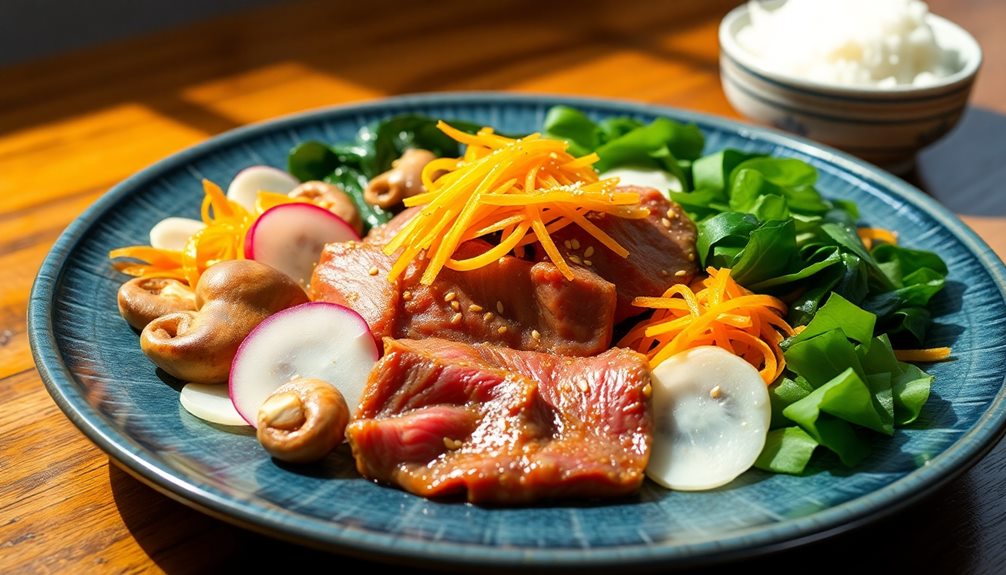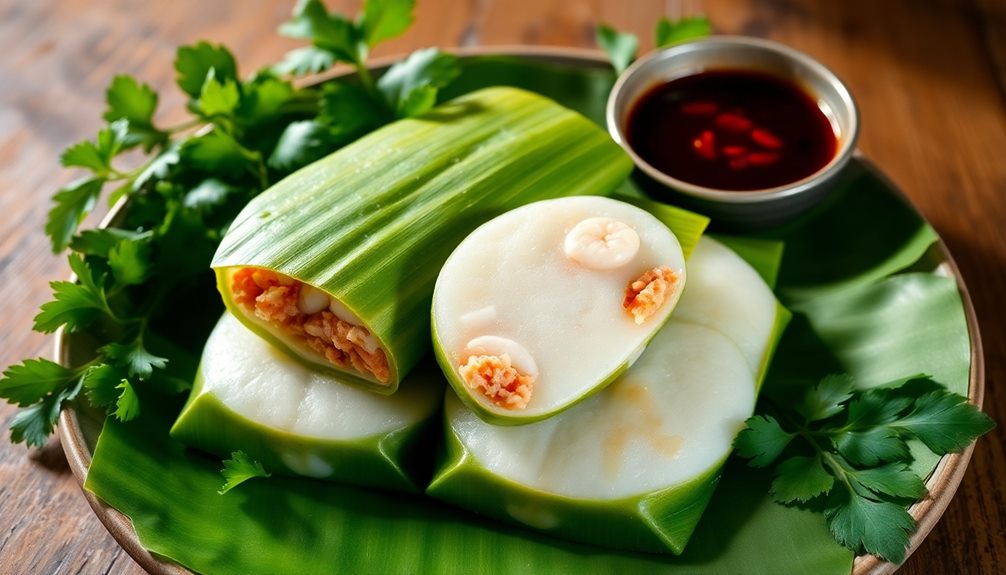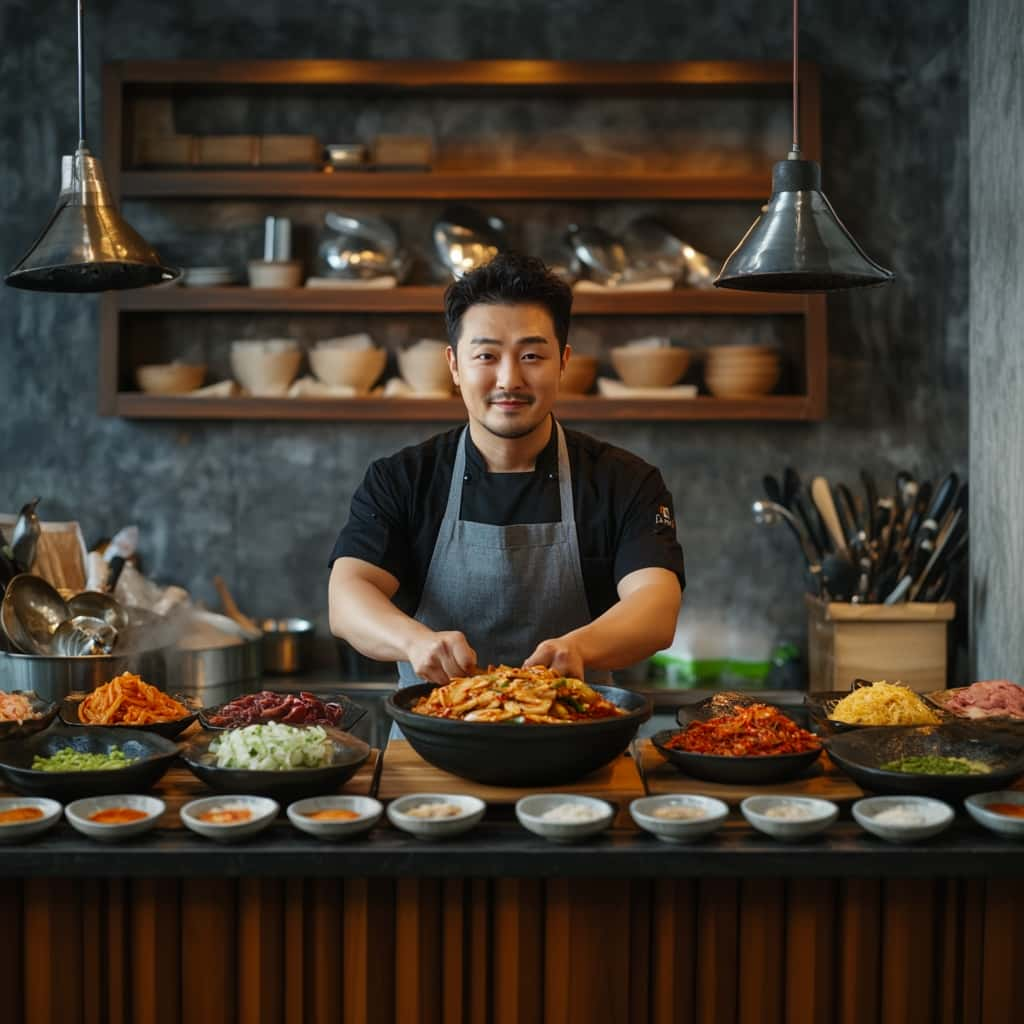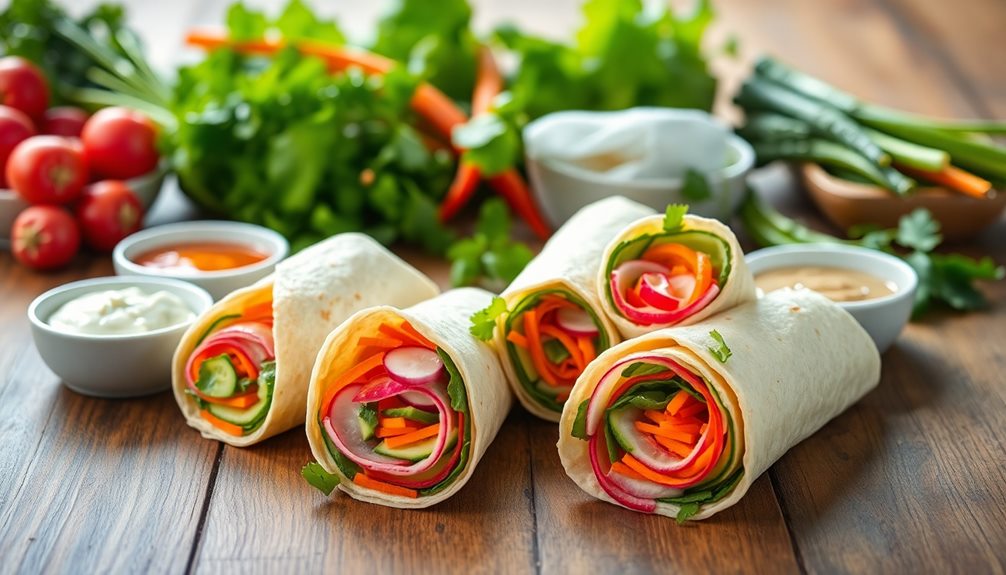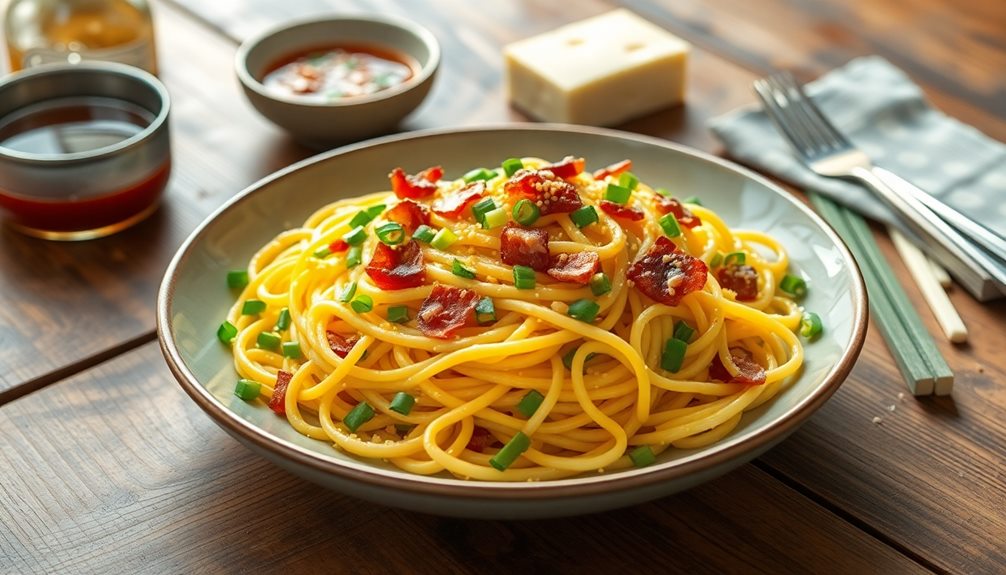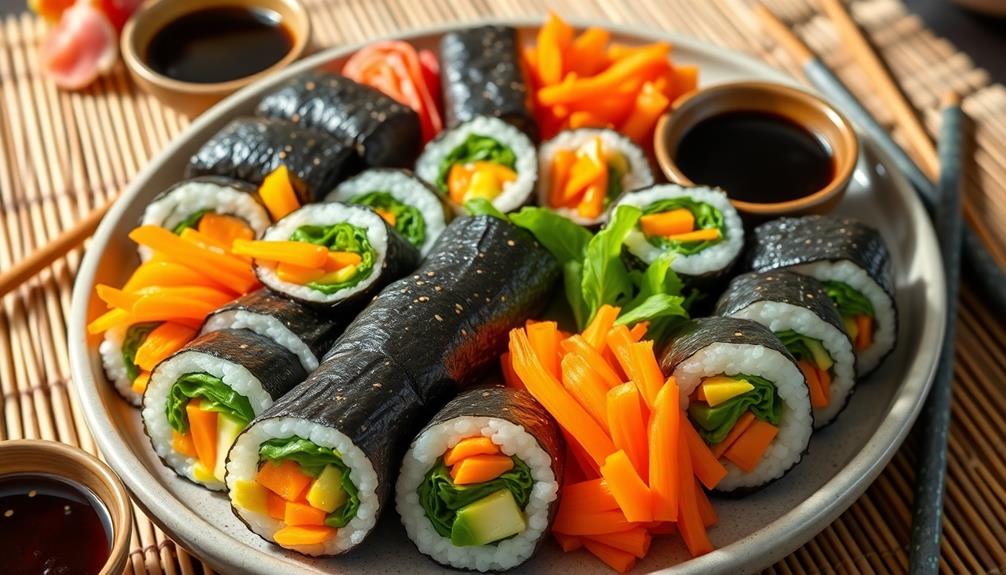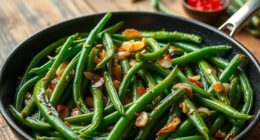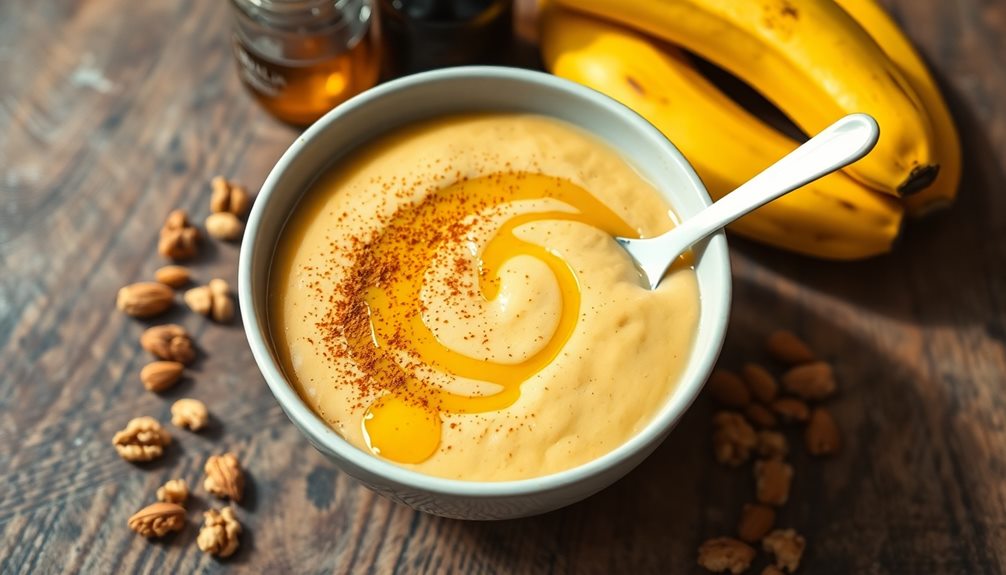Surasang is a tasty adventure that lets you experience the royal court meals of Korea! This traditional feast, served to kings and queens, focuses on the balance of flavors and beautiful presentation. You gather fresh ingredients like Korean radish, perilla leaves, and special sauces, setting the stage for a delightful cooking experience. After marinating proteins and creating colorful side dishes, you arrange everything in a way that makes your plate pop with color and texture. With each bite, you connect to rich Korean culture and history. Stick around to discover more about this special culinary journey!
Key Takeaways
- Surasang is a traditional Korean royal court meal that emphasizes harmony and balance in flavors, showcasing culinary artistry from the Joseon Dynasty.
- The meal features carefully curated dishes that tell stories, connecting generations and reflecting cultural heritage and social status.
- Fresh, seasonal ingredients, including proteins, vegetables, and special sauces, are essential for crafting this sophisticated dining experience.
- Aesthetic presentation is key, with a focus on color diversity and balanced arrangement of dishes to enhance visual appeal.
- Traditional sides like kimchi, pickled vegetables, and savory pancakes complement the main dishes, creating a memorable and sensory dining experience.
History
Surasang has deep historical roots, tracing back to the Joseon Dynasty, when it was served in the royal court. Imagine being a part of the grand banquets where kings and queens enjoyed elaborate meals! Surasang was more than just food; it was a way to showcase culture and tradition. Each dish served had a special meaning and was carefully prepared to reflect the season and the occasion.
During these royal feasts, chefs worked tirelessly to create a beautiful array of colorful dishes. They wanted to impress not just the taste buds but also the eyes! The meal usually included rice, soup, meat, and vegetables, all arranged in a stunning display. The importance of balance in flavors and colors made Surasang unique and delightful.
As time went on, Surasang became a symbol of Korean heritage. Even today, people celebrate this rich history by enjoying similar meals at special gatherings. When you sit down to a traditional meal inspired by Surasang, you're not just eating; you're connecting with a vibrant past filled with stories of royalty, culture, and togetherness.
Cooking Steps
To create an authentic Surasang meal, you'll need to follow a series of precise cooking steps that highlight the unique flavors of each dish. First, gather all your ingredients. You'll need fresh vegetables, meats, rice, and various spices. Make sure to have everything ready before you start cooking!
Next, prepare your rice. Rinse it well under cold water until the water runs clear, then cook it in a pot with the right amount of water.
While the rice is cooking, you can start on your side dishes. Slice vegetables like radishes and cucumbers, and sauté them with a bit of sesame oil for a tasty crunch.
For the main dish, marinate your meat in soy sauce, garlic, and ginger. Let it soak up those flavors for at least 30 minutes. Grill or stir-fry the meat until it's perfectly cooked.
Step 1. Gather Traditional Ingredients First

Gathering traditional ingredients is a crucial step in preparing an authentic Surasang meal. You'll want to start by finding fresh and high-quality ingredients that reflect the royal flavors of Korea.
Head to your local Asian market or grocery store, where you can discover exciting items like rice, various vegetables, and spices.
Look for ingredients like Korean radish, perilla leaves, and sesame oil, which are essential for adding unique tastes. Don't forget to grab some fish or meat, depending on your recipe, and make sure they're fresh! For a refreshing side dish, you might also want to try a Korean style pickled radish recipe, which pairs perfectly with many traditional meals. Simply marinate the radish in vinegar, sugar, and salt for that vibrant, tangy flavor. Serve it alongside your main course to introduce crisp texture and balance to your meal.
You might also need some special sauces like gochujang (red chili paste) or doenjang (soybean paste) to create that rich flavor profile.
While you're shopping, keep an eye out for seasonal vegetables. Fresh, vibrant produce will make your dish not only taste better but look stunning too!
Once you've gathered everything, take a moment to admire your colorful ingredients. You're now one step closer to creating a beautiful Surasang meal that would impress even the royal family!
Step 2. Prepare the Cooking Utensils

Preparing your cooking utensils is essential for a seamless Surasang experience. First, gather your pots, pans, and bowls. You'll need a large pot for soups and a frying pan for meats. Make sure they're clean and ready to go!
Next, grab a cutting board and a sharp knife. You'll be chopping lots of delicious vegetables, so having a good knife is super important.
Don't forget about your measuring cups and spoons! These will help you add just the right amount of ingredients. If you have a whisk or a spatula, keep those handy too—they're great for mixing sauces and stirring things up.
It's also helpful to have some serving dishes ready. Traditional Surasang meals look beautiful, and you'll want to present your food nicely.
Lastly, remember to set up your workspace. Clear off your kitchen counter and arrange everything so it's easy to reach. This makes cooking much more fun!
Now that you've got your utensils prepared, you're one step closer to creating your amazing Surasang meal. Let's get ready to cook up some royal flavors!
Step 3. Marinate Key Proteins Thoroughly

Marinating key proteins is crucial for infusing your Surasang meal with rich flavors. To start, choose your proteins, like beef or chicken, and cut them into bite-sized pieces. This helps the marinade soak in better.
Next, gather your marinade ingredients, which might include soy sauce, garlic, ginger, and a touch of sesame oil. These ingredients are packed with flavor!
Now, in a large bowl, mix your marinade until it's well combined. Then, add your proteins to the bowl, making sure they're fully coated. It's fun to get your hands in there and mix everything together!
Cover the bowl with plastic wrap and let it sit in the refrigerator. For the best results, marinate your proteins for at least an hour—overnight is even better! This waiting time allows all those yummy flavors to seep in.
When you're ready to cook, take the proteins out and let them come to room temperature for about 15 minutes. This helps them cook evenly.
With your proteins beautifully marinated, you're all set to create a delicious Surasang feast that'll impress everyone at your table! Enjoy the wonderful aromas and flavors that await!
Step 4. Arrange Dishes Aesthetically

Once you've cooked your proteins and side dishes, it's time to plate everything up beautifully. This is where the fun really begins! Start by choosing a large, flat plate as your canvas. Place your main protein, like bulgogi or grilled fish, in the center. It should be the star of the show, so make it look appealing!
Next, arrange your colorful side dishes around the protein. Think about colors and textures! For example, place vibrant kimchi next to some tender greens. You can even stack or layer the side dishes to create height on your plate. It adds interest and makes it look fancy!
Don't forget to garnish! A sprinkle of sesame seeds or a few chopped green onions can make a big difference.
And remember, less is more; you want your plate to look inviting, not overcrowded.
Step 5. Serve With Traditional Sides

To complement your main protein, you'll want to serve a variety of traditional sides that enhance the flavors of your meal. These sides, known as banchan, make your Surasang experience even more special!
Start with kimchi, a spicy fermented vegetable dish that adds zing to every bite. Next, try some pickled radishes or cucumbers for a crunchy, refreshing contrast.
You can also include sautéed vegetables like seasoned spinach or bean sprouts. These not only taste great but also add beautiful colors to your table!
Don't forget about the savory pancakes, called jeon. They're crispy on the outside and deliciously soft on the inside.
For a bit of sweetness, serve a small bowl of sweetened chestnuts or jujubes. These treat your taste buds to a delightful surprise.
Lastly, a warm bowl of rice ties everything together, providing a perfect base for your sides.
When you arrange these banchan around your main dish, remember to keep it visually appealing. Your guests will appreciate the effort you put into creating a delightful feast!
Enjoy the vibrant flavors and celebrate this wonderful culinary tradition!
Final Thoughts
Typically, savoring Surasang offers more than just a meal; it's an experience steeped in history and tradition. When you sit down to enjoy this royal court meal, you're not just tasting the food; you're stepping into a world where every dish tells a story. Each bite connects you to the past, giving you a glimpse of the flavors enjoyed by Korean kings and queens.
As you share this meal with family or friends, you'll feel the warmth of togetherness that food brings. It's a chance to connect, laugh, and create memories.
You'll discover that every dish is carefully crafted and beautifully presented, making the experience even more special.
Don't forget to embrace the colors and aromas of the meal. The vibrant vegetables, tender meats, and fragrant spices come together to create a feast for the senses.
Frequently Asked Questions
What Are the Nutritional Benefits of Surasang?
Surasang offers a variety of nutrients, providing balanced proteins, vitamins, and minerals. You'll enjoy diverse flavors while benefiting from the healthful ingredients that promote digestion, boost immunity, and enhance overall well-being. It's a delicious choice!
How Is Surasang Different From Other Korean Dishes?
Surasang stands out because it's a meticulously crafted royal meal, showcasing diverse flavors and textures. Unlike typical Korean dishes, it emphasizes balance, presentation, and historical significance, offering you a unique culinary experience rooted in tradition.
Can Surasang Be Adapted for Vegetarian Diets?
Yes, surasang can be adapted for vegetarian diets. You can replace meat with plant-based proteins, use vegetable broths, and incorporate a variety of vegetables, ensuring the dish maintains its rich flavors and traditional essence.
What Beverages Pair Well With Surasang?
When pairing beverages, consider traditional Korean teas like green tea or barley tea. You might also enjoy a light, crisp makgeolli or soju, which complement the flavors beautifully and enhance your dining experience.
Where Can I Find Surasang Restaurants Outside Korea?
You can find Surasang restaurants outside Korea in major cities like Los Angeles, New York, and Toronto. Search online for Korean fine dining options or check local food blogs for recommendations. Enjoy the culinary experience!
